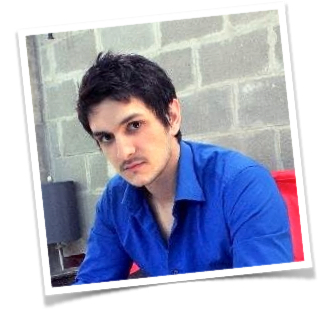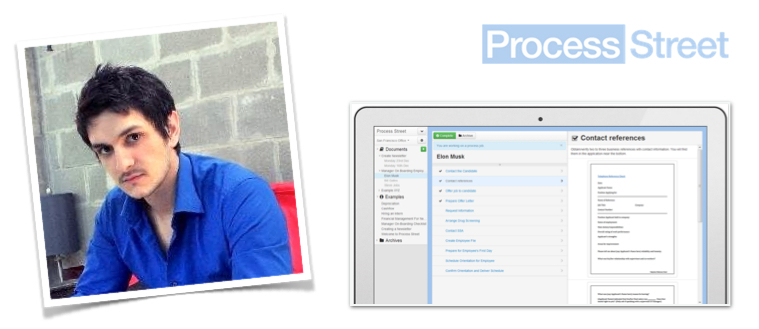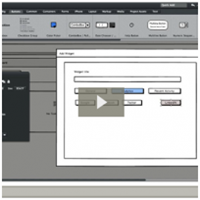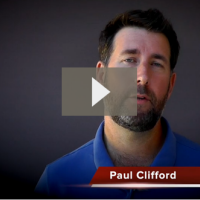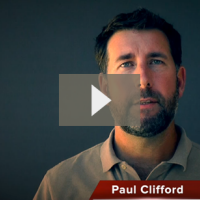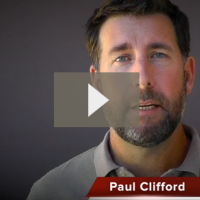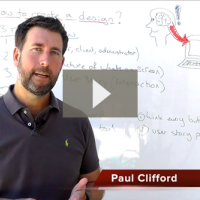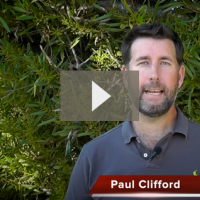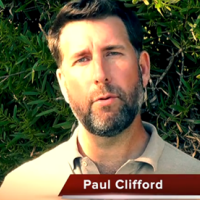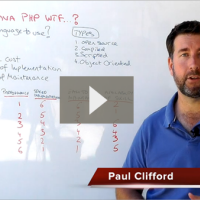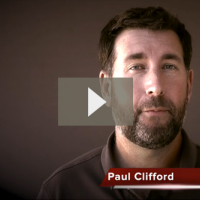Vinay Patankar, the founder of Process Street, a new SaaS startup, discusses the lessons learnt from his first startup failure, why Process Street solves a big itch for any business that needs to scale. We discuss why its important to focus on product feedback and validation, get traction (new customers) and focus on the user experience long before you attempt to get funding.
Podcast: Play in new window | Download
Todays' Podcast Highlights
[2.10 - being in San Francisco really helps your networking]
[3.16 – Build your product and get customers before talking to investors]
[4.49 - Mistakes to learn from – not getting traction, team too expensive to scale, no UX testing]
[8.25 - Balsamiq is a great tool for building wireframes]
[9.20 - UX (User experience) is more important than screen design]
[11.22 – Used a pitch deck to get Tech co-founder on board]
[12.44 – Get a tech partner who believes in the vision]
[13.56 - Outsource WordPress site build, recruiting a content marketer and mobile developer]
[15.49 – Scratched my own itch with outsourcers]
[16.29 – Wanted a rich experience with creating SOPs]
[17.31 – Could not find another solution]
[18.16 – We want to make it amazing]
[20.00 - Step by step checklist with Rich content to support it]
[20.25 – Helps remove yourself from being the bottleneck in your business]
[21.35 – The Lean Startup should be at the top of your reading list]
[21.57 – Make decisions based on real user data]
[22.17] - Your startup is proven when you’ve proved your product market fit and your growth hypothesis]
[25.20 – We see Process Street going a lot bigger than just outsourcing market]
[26.53 – Master one niche first, then expand]
[31.40 – Using a lot of great tools gives you insight into good user experience]
[34:00 – Only put in features that are essential]
[36.18 – Never promise a feature timeframe]
[36.40 – Technical Platform]
[38.00 – For $125 per month we have an infinitely scalable platform that’s super lean]
Disruptware is building the largest community of software entrepreneurs on the planet. Make sure you are on the list.

Full Transcript
Paul: Okay. I'm really keen to introduce you guys to Vinay Patankar from Process Street. Now Vinay is just in the process of launching his MVP. He's in beta phase and Process Street is a tool to manage basically teams tasks as a productivity tool. So if you think of standard operating procedures and outsourcing, then he's really come out with an ideal solution for a real market need. Vinay, welcome to the show.
Vinay: Thanks for having me Paul.
Paul: Excellent. First of all, tell me a bit about yourself. Who are you and what do you do with Process Street?
Vinay: Sure. My background is a bit of a mixed bag. I'm originally from Australia. I've got a background in IT and sales, marketing business. I worked with software recruiter for a while as well as worked in technology and for the last four years I've been traveling as a digital nomad running an online lead generation company, launched two startups. Process Street being my second one and I've been working building Process Street products for about the last six months.
Paul: Wow! You're not actually based in the U.S, are you? You're based in Argentina, Buenos Aires?
Vinay: Yeah, we're currently in Buenos Aires. Basically the last startup that I ran I was in San Francisco and we went through an accelerator and didn't get the traction we wanted so kind of ended up shutting that down. When building Process Street, we thought, okay, we could stay in San Francisco or go to another U.S city or we could just go to somewhere that is cheaper and having a new experience of living in a different city, kind of like a semi-holiday if you will. But because we were just building the product, we didn't really need to be near any of our customers or anything at that current stage of the company. It was just about going somewhere that would be fun and a good experience and just giving ourselves like the time and flexibility to put our heads down and actually just focus on building the product.
Paul: Do you think it's really important to sort of be in the valley, be in the bay area to actually get investors on board?
Vinay: I definitely really think it helps. There's a huge difference between the environment of being in San Francisco or in the valley than being anywhere else in the world because just everyday all your interactions, you're surrounded by people who can either help your business in some way or know somebody who can help your business in some way. By just going to the local Starbucks or going out to a bar for a beer in the evening or whatever - there's just like always people around that kind of work in that same space and are interested in what you're doing or have connections to people that might be useful. Whereas, in all the other cities … most of the other cities in the world there isn't that same type of exposure. I don't think, I mean if you have an amazing product, attraction, sure you don't need to be in there but I think that just from the networking perspective, you're going to get more opportunities to pitch more people, so you can generate more leads by being in San Francisco than not.
Paul: Got it. I often tell people that nowadays, because software is a lot faster to build and develop it really does pay to sort of get your first customers on board and show some traction before you go out to the investor community and start scaling. How do you feel about that notion?
Vinay: I absolutely 100% agree. If you check out my postmortem on my last startup which was Vitoto and just type in 'why this failed'. That was one of the things that I talked about and that was a big reason for why my last startup failed, was because I went in too early trying to raise money instead of just putting my head down and focusing on the product. So I think that there's different stages of a software startup and I don't think that you need to be in San Francisco like right now when you're actually building your MVP. In fact, the cost of living in San Francisco is so high that I probably recommend you don't go while you're building your MVP and use the money that you would spend living in San Francisco on making your product better and once you get to a point where you have some customers, have some traction, you know then and you think that it's ready to kind of take to a new growth stage. That's the point where you consider going back into San Francisco or raising money.
Paul: Okay. When you did your first startup, you hinted at this about some mistakes you made. What, looking back, would you never do again? What could you tell sort of you know to our tribe or what kind of advice could you give them when they're thinking about building their startup?
Vinay: Sure. There was a number of things that I think we did wrong. One of the first things was, like you mentioned before, was not getting traction. It was … what I basically … and not getting traction came down to kind of I guess a planning error. What that was, was with our budget and planning like, okay, we're just going to get an MVP out the door and once the MVP is out the door, it's going to be awesome and then we're going to get traction and get money. That was a huge mistake in thinking that we really need a budget up till the MVP, because once we launched the MVP we were like, oh man, we actually have six months worth of iterations and learning from customer feedback to actually get this to a point where it can get traction and we didn't have the runway or the budget to do all those post MVP iterations that were needed and without the traction it was very difficult to raise money, so it was kind of like this catch 22 situation where you need the money to get traction, you need the traction to get money and that wasn't planned for from the beginning and that was one of the crucial mistakes.
That was probably the most crucial mistake and then kind of the things that tapped into that were, for example the team. Basically the team that I kind of put together for Vitoto was a very experienced team, but also expensive. There were two guys from Australia and they had a lot of overhead, more because … offices, stuff like that that needed to be covered and Australia is definitely not cheap to operate in either. So that kind of meant that our runway didn't last as long. We kind of didn't … we didn't do enough UX testing so that was another problem. We should have done a lot more kind of paper testing or mock up testing of users to make sure that the UX flow was great because without a strong UX it was very difficult to get the traction we needed and we learnt that after the MVP came out and after we'd kind of spent a lot of the money whereas we should have learnt that before, at the beginning, and done cheap tests. I think there's an app called POP. Have you heard of POP?
Paul: I haven't heard of POP actually, no.
Vinay: POP is an app that … it's an iPhone app and basically what it lets you do is draw mockups of software … of screens for an app. So you can have like this is what my screen is going to look like, this is where a button is going to be, this is where a video is going to be, this is where comments are going to be. Then you can draw multiple screens and then you can actually link the screens together, so you can kind of fake the experience of your app using POP and then … so they say like a great way of doing kind of UX testing is to … and this is something that we should have done, but we didn't … is kind of mockup your app using this tool and then walk around and get people to use it. You can actually do UX testing without even spending a cent on development.
Paul: Right. Actually … so it's essentially like a wire frame tool, but you can actually build screens and their clickable.
Vinay: Yeah, it's a clickable wire framing tool. You can link those together and actually give it to someone and say, “Hey, try and use this.”
Paul: Got it.
Vinay: Then you can kind of watch them.
Paul: What I use is Balsamiq, which is similar … it's very quick to build wire frames and you can link all the buttons and everything together, so it is very, very clickable but it's the stage before getting a designer involved. You can actually test a concept with prospects straight away even though it doesn't look pretty, but it still enables you to test the workflow and get feedback immediately as a validation as to whether this model is actually going to work.
Vinay: Yeah, and I don't think that looks are very important any more. On mobile apps I think they're probably more important, but I think design is a bit of a commodity these days. You have things like Bootstrap and you have themes and all that kind of stuff which makes design pretty simple. I think that the actual UX, the experience, like the flow of the app is much more important than whether it's got pretty colors or not.
Paul: Exactly. That's spot on. What other tools do you use when, you've obviously got a small team together for Process Street, what tools do you use to sort of communicate with them on your ideas and your concepts and so get that validated and in to code?
Vinay: For me, I … well, I live with my co-founder, who is my CTO.
Paul: So yes (laughing).
Vinay: We generally just shout.
Paul: That's one way of doing it, isn't it?
Vinay: We kind of shout across the living room. We do a lot of our communication just through Github. And the reason we do that is we try and keep it in Github, because you can actually attach your communication to the code itself. When there's an issue or an error that … or a bug that comes up or a feature that needs to go in, if we communicate that within Github, that can actually be attached to the code itself as like a comment or whatever and that kind of reduces the workflow of having to jump between two different apps for Cameron, for our CTO. He can kind of do everything just in one. That's kind of our main communication tool outside of the normal like phone call, face to face, Skype kind of communications. We'll go over things kind of at a higher level and then when things get locked down, then we'll put it into Github and use that as the kind of main way of tracking everything.
Paul: Okay, good. When you first had the idea, did you do any mockups or anything like that to explain that to your CTO?
Vinay: Yeah. The first thing that I did was … it wasn't so much a tech mockup, it was more of a product pitch deck, because I guess the difference was that Cameron's a co-founder. So this was actually another thing that … another lesson that I learned from Vitoto. It was actually that I definitely wanted my developer to be a co-founder. I didn't want them to be an outsourcer, because I've built software before with outsourcers and that was one of the issues with Vitoto was that like this kind of running out of runway. I wanted to keep it as lean as possible.
I wanted to find someone who wouldn't just like … oh, that's a nice piece of software we can build it. I wanted someone who actually believed in like the vision of the company and believed that it could be successful and was going to be more committed than just someone that you pay to kind of build something. Because 'A', like I knew that from my past experience you're going to get a lot of bugs, you're going to get a lot of problems and you're going to need to fix them and it's always going to take longer and be harder than you expect it to be and all of that costs money if you're paying someone.
You might budget six months, but every single project that I've ever done in software has always been over budget and overtime. Kind of taking that experience, I wanted someone who was on board and believed in the vision and was able to commit more than just … was willing to commit more than just the normal 40 hour work week and more than if the budget runs out it's like the thing isn't over, it's like let's figure out something. You know what I mean?
Vinay: Kind of that … I wanted that flexibility to be able to go longer than needed and to be able to make more mistakes, because I think that they always happen in software.
Paul: Of course and you know that's a very obvious way of doing it. You know working with a really, really good tech partner. Obviously the disadvantage to that is you're sharing your equity right from out the gate.
Vinay: Right.
Paul: But you're right in that you get buy in straight away and because of that your communication loop doesn't have to be strong either.
Vinay: Yeah, because you're working so close to that person, but I mean like Cameron charges $130 an hour, freelancing. For me to pay him for six months or even a year and a half or whatever it's going to take, it would be very expensive. That's kind of a trade-off of equity versus paying someone, right?
Paul: Exactly. Is it just the two of you at the moment or are you looking for someone else as well?
Vinay: Yeah, we're the two co-founders. I mean, I do have to have outsourcers to help with marketing and to help with like the front end, WordPress website and stuff like that, which is kind of all my domain, so Cameron basically just focuses on the actual app, the actual core products. And then everything else is basically me and outsourcers helping me get the rest of the business tasks done. So that's kind of the current setup. But yeah, I mean we are definitely looking to grow. I'm looking for a content marketer at the moment and we're going to be looking for a mobile developer in probably a few months as well.
Paul: Brilliant. So the product itself is a way of people who outsource a lot to create their standard operating procedures. Okay, so you're really simplifying the whole process and by simplifying it you're encouraging people to create more SOPs which of course is something that every company needs to do if they really want to grow and scale. How did you come across that idea - the whole concept? Why did you decide to go into that? Did you any sort of market research? Are there competitors out there in the market right now doing that and how did you decide that there is a niche worth going for or gap in the market?
Vinay: Sure. Another thing that I learned from my first startup. You know my first startup I kind of just built it, because I was like, “Wow, that's a cool idea. People will probably like this,” and I talked to some people about the idea and they were like, “Oh yeah, it's a cool idea,” but there wasn't really any validation. For this idea, the point that I started was from scratching my own itch. I have an online lead generation business and I work with a number of outsourcers myself and I was frustrated with communicating tasks effectively to them.
I was frustrated with being able to quickly create standard operating procedures. I was frustrated with repeated mistakes from my team and I wanted not just a way to be able to create standard operating procedures quickly, but I wanted a way to actually be able to track and see when and how those tasks are being done as well. So I needed a richer experience. And this was basically … I'm like this seems like a pretty simple product. Surely, there is something already out there. And I just couldn't find anything that had the experience that I wanted.
There are a number of document management systems, there are … you can use stuff like Google docs and there are a couple of … well, there's actually a number of SAP software competitors out there as well, but most of them use very old technology and they kind of structure it like a template document management. It's not very attractive. It's very old in terms of the tech and user experience was just nowhere near up to kind of what I come to expect from modern SaaS apps.
I'm looking for something that's like a Trello or like an Asana. That is a really smooth, easy, fast way of doing it and kind of all the products that I came across were clunky and slow and ancient. I'm like, okay, this something that I'm willing to pay for right now. I have my card out trying to buy something and I can't find a solution for it. That was kind of the point that I started from, just trying to fulfill my own need and through that I kind of said, “Okay, this is the opportunity,” and then I built a pitch deck and basically just started showing that around and gathering feedback and kind of went from there.
Paul: Brilliant. I've noticed in using the app it is really slick. You followed sort of the Trello style technologies you mentioned, in that everything sort of in the browser so it's very quick and interactive to use and of course you really focused on simplicity. which I really, really like a lot.
Vinay: Right.
Paul: What are your goals with the product? Where do you want to take it?
Vinay: We want to make it amazing. We think that right now, it's kind of a core product. The experience is getting there from the simplicity of the features, just to explain how it works with the people that might want to use it but basically what you can do is you can come and you can create a process template or a standard operating procedure template, and the way that we structure that is we structure it as a checklist, so you can put each task … say your checklist is doing a weekly newsletter, so the first thing is you've got to write the content, you've got to proof the content, spell-check it, put a gather on any additional things, the resources, you've got to put it into Mailchimp or whatever you've been using, you've got to schedule it and then potentially depending on who's doing it you might get a manager to review it and check off and make sure that it'sgood to go out. It's that kind of process that needs to be done each week to create a weekly newsletter for the company.
That basically it, it's a step by step process. Step one would be with the content, step two would be run your spell-checks, step three would be to load it into mailchimp etcetera, and the way that you can build a template is during the step by step checklist. What we've actually done is taken it a step further and allowed you to add in rich content into each of those checklist task items. If your task is add the content to mailchimp, inside that you can have videos and screenshots which … explaining exactly how you wanted to do it. It could explain what they should name a campaign and exactly how the text should be formatted or exactly how … or … what dimensions do you just need to be, and you can talk through it using a screencast and like demonstrate past whatever.
You can create this kind of very specific way of doing these tasks in a manner so that A, it keeps your quality high and consistent, so when people are doing it, each email that goes out each week is just the same or at least the same kind of structure formatting. B, it's documented in so much detail that if the person doing it ever leaves or is sick or wants to hand it over to somebody else or transfer to somebody else, then somebody can take over that job. It helps with training new employees, it helps with removing downtime, with people being sick or leaving and it helps you systemize and take a step back and remove yourself from being the bottleneck in your business.
Paul: Excellent. Now it's actually good. I think we'll put a link below this podcast as well so people can actually go and take a look at the product and at the moment you're in beta phase, aren't you? You're testing and you're looking for feedback from customers. You want more people to use it so that you can really really identify with it as a good fit, right?
Vinay: Yeah. That's basically how we're taking it. We're following a lean startup methodology for anybody who hasn't read that and is looking to create a software product, definitely highly recommend it as one of the top of your list books to read and basically they talk about just following this kind of lean development cycle where you get the most basic vital product as possible and instead of you trying to make assumptions of what your users want and need you get the product out and you start talking to our users and then you make your decisions based on the feedback that you get from your users. It's like you actually make a decisions based on real data. That's what we're trying to do; we're trying to get as many people on and figure out what the most requested features are … and what these bugs are and we adjust our products based on the feedback from our users.
Paul: Okay, brilliant. Now what is your traffic strategy? Once you get this live and you're ready to sort of really get people on board, how are you going to go out to market and actually get people to sign up?
Vinay: Yeah. It's a good question. From my learning from my last startup, there are two things you need to prove; you need to prove your product market fit hypothesis and then you need to prove your growth hypothesis. Once you've kind of proven both of those two things, you're at a point where your startup is basically to perceived this proven or validated and it becomes pretty easy to say raise money or get more traction. First that would be one, the other one is proving product market fit hypothesis which basically means is the product valuable enough that people actually want to pay for. That's kind of the first step. The second step is proving your growth hypothesis, and the growth hypothesis basically talks about can you get a good enough customer acquisition cost relative to your life time value of your customer.
That's going to be our next challenge and basically to answer that question, I don't know exactly what kind traffic strategy is going to work best but what we're going to do is run a series of tests across different traffic strategies to figure out which one is the best customer acquisition model for us. The things that we currently have been trying is content marketing, so getting a content marketing team, doing various different content. I know you have a product Kudani so just sort of testing out some tools like that and just rolling that back in the content marketing strategy.
Also with content marketing, we're kind of looking at doing some more advanced stuff, so doing re-targeting on content, pushing content views to kind of build the blog subscriber base using paid track sources and so we're targeting through Facebook or in Facebook ads, running Youtube retargetting, we're targeting at stuff like that. Beyond content marketing, look at just generic paid campaigns, so Facebook, Adwords, and then you mentioned this before, running ads on Freelancer, so I think that's a good idea as well.
Paul: Yeah, you need to sit around anyone who's outsourcing, so any tool, product that they … anything like that where people are involved in outsourcing. Another site is like the jobboards for the Philippines for example, all those job boards, they'd be perfect for that.
Vinay: Yeah, as I was saying, it's definitely a great … I guess that we want to start on outsourcing but I think going back to your question before I didn't answer properly, where do we see Process Street going, we definitely see it being a lot bigger than just targeting the outsourcing market. Already now we have a number of users and customers that run that space. We have patent lawyers that just like … they use it for every time they need to run through like a patent check. We have financial advisors in the real estate companies to follow the process. Like every time they need to get over documents for someone to close a deal on a house.
We have IT maintenance or infrastructure companies using it every time they needed to deploy a server, they run the process. Then we want to grab into for example mobile, so for building inspectors, people that need to go around and do inspection, run boarding, check the litter, check the piping, attach it, integrate it in the photos or stuff like that. We definitely see it as being a much larger product than just the outsourcing space but as the product is kind of built as a beta product, we don't have mobile, we don't have some of the more advanced stuff that maybe finance companies might need, so just parallel processors or like process dependencies starting … getting a little bit closer to the BPM space, but outsourcing is definitely a great place for us to start and get initial traction and.
Paul: I think you're absolutely right and I think the great thing with these types of products is being able to specifically target one niche and if you master that niche then you can sort of grow and target another one. I was at an event the other day and the one comment that came out of the event was like if you look at Facebook, what's Facebook's market?, well basically anyone with a face, but when they started, their market was just Harvard and all they did was conquer Harvard, and then once they did that then they expanded it to the other Ivy League universities and then after that they went after everything.
Vinay: Yeah. It's a pretty common story I think because it's like basically as a startup you don't really have resources to target everyone and also it's difficult to kind of get your messaging correct, and honestly that's been a bit of a challenge for us, is trying to figure out exactly which markets to target and kind of drilling down on our niche, and it's something that we still need to work on.
Paul: Cool. That's really good. Now obviously you're a software entrepreneur and you've got other businesses as well. How do you keep focused or how do you sort of manage your personal productivity? Because this is something that I get questioned on a lot because there's so much going on and we also have a bit from ADD. What tools or mind set do you use to sort of really get through your day and ensure you stay on track?
Vinay: Sure. I'm definitely a productivity tool for that. I use everything. I have … I use Asana, I use Trello, I use Workflowy, I use … Evernote, I use Street and yeah, we use Github for the software. I definitely use a lot of tools a lot to keep me on top and depending on what the task is and kind of what's going on, I'll use different tools. I can give you an example, so Asana I use for my lead generation business mostly. I honestly don't actually use it myself that much, but I have my team use it and Asana is great because it logs everything, so it's a way for me to go in and kind of if there's ever an issue or if I need to get data on a particular project or whatever, I can go in and kind of check that, but I find it's a bit slow to maybe use myself. Trello I use for content, so I find it great to kind of visualize posts as they're being created and guest posts and that kind of strategy. Workflowy I just use to organize my brain.. just to dump. I don't know if you … have you ever heard of Workflowy?
Paul: Yeah, yeah. Love its simplicity.
Vinay: Yeah, so I use Workflowy just about … I used to use Evernote for this, so just kind of dumping thoughts there I find that Workflowy has a much nicer structure just for tech ideas, and then I use Evernote for document management, screenshots and just trying to like clipping different sites and websites and everything like that, so just dump everything into one place that I can do searches on. That's what … I'm not a very like organized person, so tools like Evernote and Gmail, where I don't have to actually think about how I'm going to organize something, I can just dump everything I want into it and I can use search to find something quickly, are tools that I really like. Workflowy is the same kind of way. Even though there's structure in Workflowy, I still have only used the search feature because to me I'm more about like dumping stuff in and then recall it quickly without having to figure out where I'm going to organize what I'm doing.
Paul: Brilliant.
Vinay: Yeah, I use a lot of tools but I don't know if I'm probably the best person to talk to about productivity because I'm a bit of a mess on those.
Paul: Aren't we all, right? Cool. What would you sort of recommend for people starting up? What would you recommend as the best books to go out and read?
Vinay: If you're looking to build a software product?
Paul: Yeah.
Vinay: The lean startup up definitely is a great one and then it's going to come down to I guess what your experience is. For me … one great thing I find is … from being a very heavy user of a lot of kind of different tools and apps is that it gives you a great insight into user experience form a product perspective, but … I know there are a number of great design and UX books out there which I haven't really read that much. If that’s something that you don’t have much experience with then I think that UX is the most important thing. It really depends on the level of experience you have. There are great books from 37 signals and I've read all that stuff. They talk about … there's like their main book (about building basecamp) I remember it talks about like how they do it basically and they basically talk about kind of building a product without trying to look for funding.
They build it themselves, they focus on … they talk about how they do base camp in the first part, so they were a team of building the web consultancy and if you know they built Ruby on Rails and they have a base camp and a bunch of other really really really successful such products. They were a team during web consulting and they kind of used their web consulting business to generate revenue and then on the side as a side project they started building base camp and they didn't go out and look for funding, they didn't try and get it done quickly, they just thought like fun for that … fun the way it is, just making it better better better and never kind of about that stress of running out of money or anything like that because they already had a profitable consulting business and they just kept doing that until they got to a point where it was generating enough revenue and had enough users so that it could actually stop their consulting business.
Paul: Absolutely.
Vinay: That's part of the model we’ve taken with Process Street as well, so that then it's a lot lower stress and also like I mentioned before, there's so many unforseens with building software. If you're a first time software entrepreneur, whatever budget you put out, whatever like timeline you set triple both of those things. There are so many things you're never ever going to imagine that would come up that are going to come up and if you go, “Okay, I have 20 grand and three months to make this happen,” I would say it's a pretty risky position to put yourself in.
Paul: Yeah, absolutely. The book by the way is Rework.
Vinay: Rework?
Paul: Yeah, and some of the things that also come out of that that I really love is first of all saying no to feature requests because one thing that base camp is great for is simplicity and ease of use and that's all down to being really strong and resisting customer pressure and really only putting in the features that are really really essential and add value because it's really really easy especially in the early day to build feature after feature after feature thinking that this is what's going to make the product great, but in fact what makes the product great is the user experience.
Vinay: Exactly.
Paul: Okay, and that's the key thing right there.
Vinay: Yeah, there's a lot of mistakes people make around that. See, I think you want to keep it as simple as possible and the thing is you want to … especially when you're just getting it brought out. Don't hold back your release of your product because … and this is kind of a lean startup methodology, don't hold back the release of your product because your think you need todo this feature. Don't worry about it. The first versions of Twitter or Facebook, of every single product that you know that were out, absolutely horrible, don't even look like they look like now, and they would have never gotten to that point if they hadn't have released those products earlier on and gotten the feedback and adjusted their development trajectory based on the feedback that they got.
You want to get the product out as soon as possible, don't hold back extra features. When you do want to build the features, make sure that the features that you're selecting are the features that have been most requested by your most aligned customers. Ideally, customers are paying and if one person asks for one feature at once, don't go, “Okay, we'll do it.” Wait and make sure that a lot of people … that it's a kind of a highly requested feature so that you know that you're going to be satisfying a larger portion of your customer base versus just like one person who needs one thing done. Also, another tip, never ever tell somebody that you're going to have a feature done by a particular time.
Paul: Yep.
Vinay: Even if you know you're going to be building that feature, don't say, “Yeah, we're going to have it done in two weeks,” because you're probably not. Just say, “Yeah, it's out, it's on the roadmap that we're going to be working on in future.” Don't give a time because people are going to come back and be like, “Yo, it's two weeks, where is that feature?” yeah, and stuff for everything takes longer.
Paul: Yeah. The golden of rule there is always under-promise not over-deliver.
Vinay: Exactly. We're setup to scale, so we're on an Amazon EC2, we've got … so there's true servers for the products. There's like the API server which is like the core app server and then there is the front end server and they're both on EC2 using load balancers and then the databases are on RDS. It's all setup on infinite scale basically.
Paul: How much did that cost you?
Vinay: That … because they're all on micros, so not much $100 bucks per month.
Paul: Right.
Vinay: 100 bucks a month for all those three servers and they're only … so then like if they get 80% load, then they spawn new servers. That cost goes up if traffic goes up. Then we're hosting the wordPress site on Pressable which we used to … it used to be Zippykid. Pressable is really cool, you should check them out now and basically they're … it's scalable wordpress hosting, so it's like they manage load balancing, the RDS and a CDN content delivery network all for you, so like all parts of the product are on infinite scale basically. It's super cheap. That whole setup is like 125 bucks a month. That's like super lean. That's one of the huge developments that happened in technology in the last five years, right. For $125 a month, we have an infinitely scalable content like CDN delivered, like worldwide service app that about 10 years ago would have required a team of sys admins to manage and build back in the data center. Now for 125 bucks a month and whatever a week worth of config, we have an infinitely scalable platform.
Paul: That's really cool. Good stuff. Brilliant. Vinay, any sort of final thoughts for any of my tribe who are looking to either start software businesses or are in the process of scaling their SaaS businesses?
Vinay: Definitely that … software is definitely one of the most fun and rewarding things I’ve done because you build like … you're building a product in the concept of delivering real value. It's kind of different to people that might be coming from marketing or stuff like that where it's kind of building a product with a great copy so you can sell it. For us with our products it's been great because we've just been focusing on trying to build a product that will sell itself, so just trying to offer so much more value than what we charge. I definitely think that if it's something that you're interested in software is the fastest growing space in the world easily and I still believe software is at 1% of its potential as a whole industry. I think that innovation in software is going to accelerate and where software is right now it's only 1% of where it's going to be 100 years from now.
Paul: Brilliant.
Vinay: Yeah, definitely I think it's a great space but definitely make sure that you're prepared for the long run. It takes time and be prepared for things taking longer and costing more than you expect. Yeah, so I just want to say that I guess if anyone wants to check out our products it's free for teams of up to three people right now and you can get it at www.process.st.
Paul: That's great Vinay. I really appreciate you coming on the show.
Vinay: No worries. It's the best thing people.
